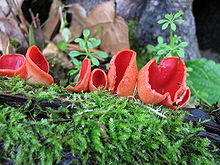
Back Sarcoscypha coccinea AST Пецыца ярка-чырвоная Byelorussian Керино ухо Bulgarian Cassoleta vermella Catalan Sarcoscypha coccinea CEB Ohnivec šarlatový Czech Coron borffor Welsh Scharlachroter Kelchbecherling German Sarcoscypha coccinea Spanish Verev karikseen Estonian
| Sarcoscypha coccinea | |
|---|---|

| |
| Scientific classification | |
| Domain: | Eukaryota |
| Kingdom: | Fungi |
| Division: | Ascomycota |
| Class: | Pezizomycetes |
| Order: | Pezizales |
| Family: | Sarcoscyphaceae |
| Genus: | Sarcoscypha |
| Species: | S. coccinea
|
| Binomial name | |
| Sarcoscypha coccinea | |
| Synonyms[1] | |
|
List
| |
| Sarcoscypha coccinea | |
|---|---|
| Smooth hymenium | |
| No distinct cap | |
| Hymenium attachment is irregular or not applicable | |
| Lacks a stipe | |
| Ecology is saprotrophic | |
| Edibility is edible | |
Sarcoscypha coccinea, commonly known as the scarlet elf cup, or the scarlet cup, is a species of fungus in the family Sarcoscyphaceae of the order Pezizales. The fungus, widely distributed in the Northern Hemisphere, has been found in Africa, Asia, Europe, North and South America, and Australia. The type species of the genus Sarcoscypha, S. coccinea has been known by many names since its first appearance in the scientific literature in 1772. Phylogenetic analysis shows the species to be most closely related to other Sarcoscypha species that contain numerous small oil droplets in their spores, such as the North Atlantic island species S. macaronesica. Due to similar physical appearances and sometimes overlapping distributions, S. coccinea has often been confused with S. occidentalis, S. austriaca, and S. dudleyi.
The saprobic fungus grows on decaying sticks and branches in damp spots on forest floors, generally buried under leaf litter or in the soil. The cup-shaped fruit bodies are usually produced during the cooler months of winter and early spring. The brilliant red interior of the cups—from which both the common and scientific names are derived—contrasts with the lighter-colored exterior. The edibility of the fruit bodies is well established, but its small size, small abundance, tough texture, and insubstantial fruitings would dissuade most people from collecting for the table. The fungus has been used medicinally by the Oneida Native Americans, and also as a colorful component of table decorations in England. In the northern part of Russia, where fruitings are more frequent, it is consumed in salads, fried with smetana, or just used as colored dressing for meals. Molliardiomyces eucoccinea is the name given to the imperfect form of the fungus that lacks a sexually reproductive stage in its life cycle.
© MMXXIII Rich X Search. We shall prevail. All rights reserved. Rich X Search